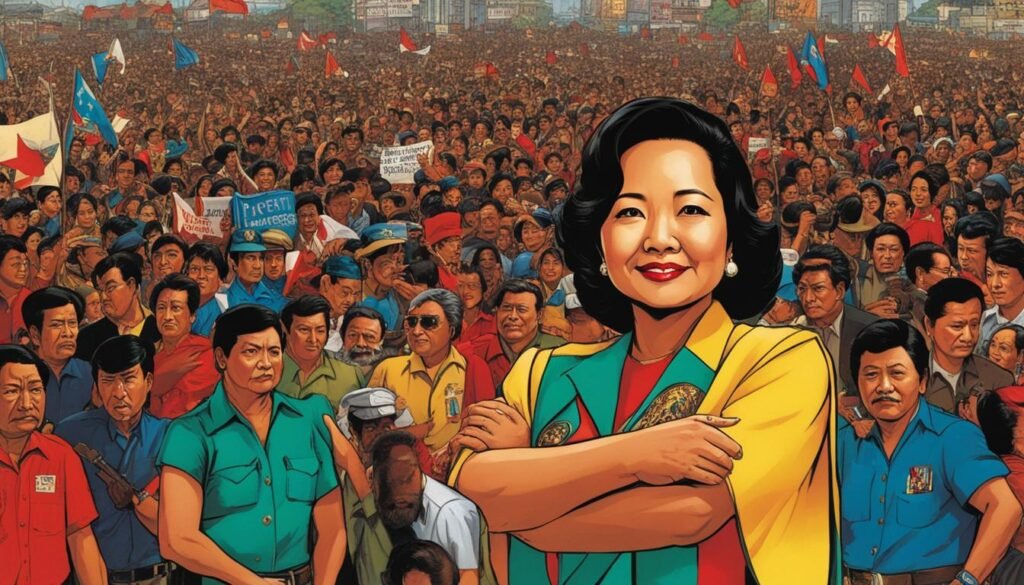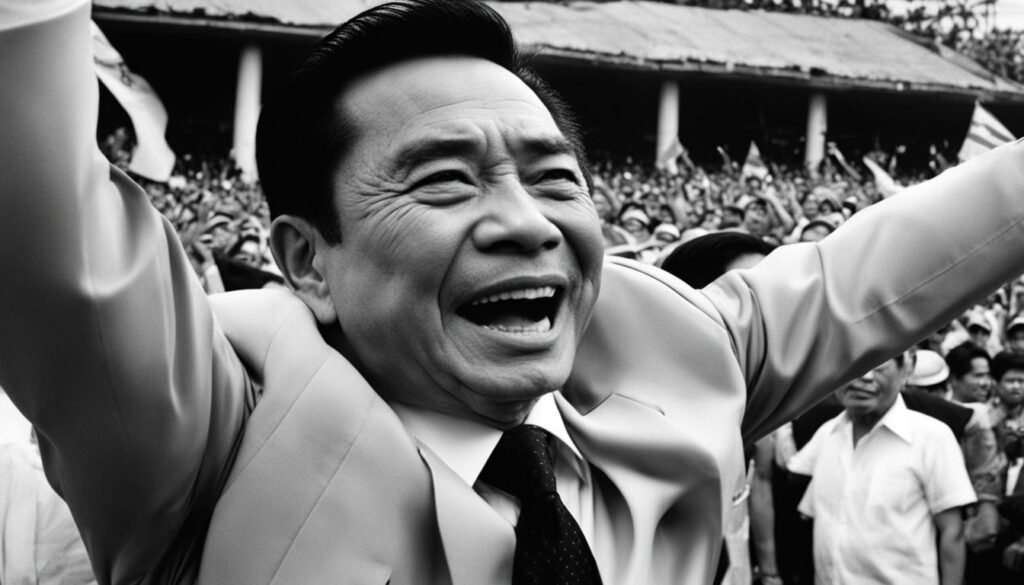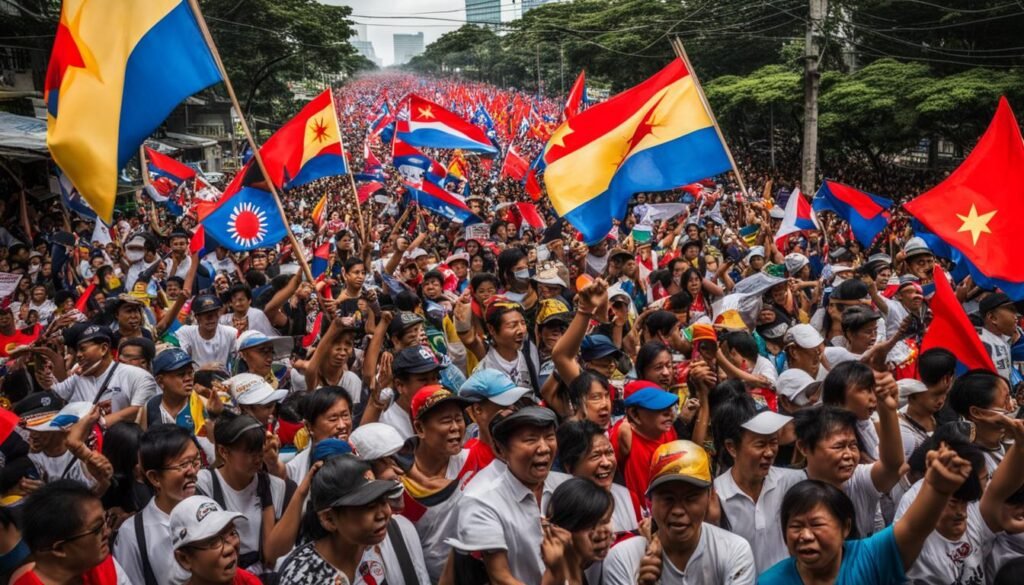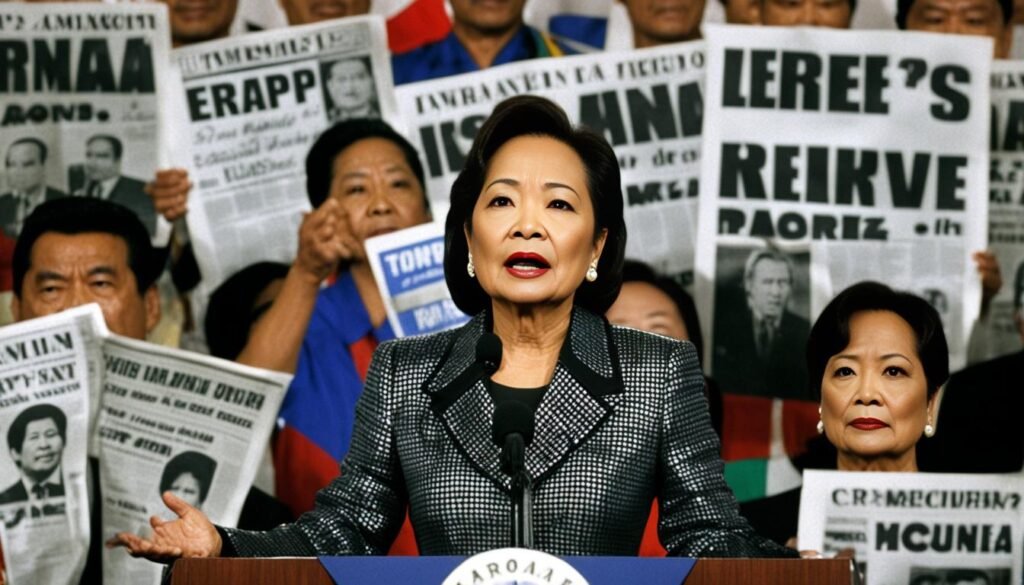The Second EDSA Revolution, also known as EDSA II or the Second People Power Revolution, was a historic event that took place from January 17-20, 2001, in Metro Manila, Philippines. This revolution led to the peaceful overthrow of President Joseph Estrada, who was facing impeachment trials due to corruption allegations.
In this article, we will delve into the causes, key players, timeline, and aftermath of EDSA II. We will explore the political landscape that led to the revolution and its impact on the Philippines. Join us as we uncover the events that shaped the course of history in the early 2000s.
Key Takeaways:
- The Second EDSA Revolution, also known as EDSA II, took place in 2001 in Metro Manila, Philippines.
- EDSA II resulted in the peaceful overthrow of President Joseph Estrada, who was facing impeachment trials.
- The revolution was fueled by corruption allegations and calls for Estrada’s removal from office.
- Vice President Gloria Macapagal Arroyo assumed the presidency following Estrada’s resignation.
- EDSA II had a lasting impact on Philippine politics and remains a testament to the power of peaceful protests.
The Causes and Goals of EDSA II
The EDSA II revolution in the Philippines was sparked by a significant event – the impeachment trial of President Joseph Estrada, which commenced in December 2000. Estrada faced damning allegations of corruption and other offenses, prompting widespread clamor for his removal from office. The overarching goal of EDSA II was to peacefully protest and remove Joseph Estrada from the presidency.
The impeachment trial served as the catalyst for the revolutionary movement, leading to a breakdown in negotiations and a surge in public dissatisfaction. Estrada’s alleged misconduct and the subsequent calls for his impeachment triggered a groundswell of support for change and propelled the nation towards a pivotal moment in its history.
The Filipino people, fueled by a desire for justice, took to the streets to express their frustration and demand accountability. They saw EDSA II as a means to rectify the perceived abuses of power and to ensure that their voices were heard. The movement aimed to achieve a peaceful resolution and the removal of Joseph Estrada as President, paving the way for a new era of governance in the Philippines.
During the EDSA II revolution, the people united towards a common goal – to hold their leaders accountable and uphold the principles of transparency and integrity in public service.
The ideals behind EDSA II were rooted in democratic values and the belief in the power of collective action. The revolution represented the determination of the Filipino people to shape their own destiny and create a system where corruption and impunity would no longer prevail.
As the impeachment trial unfolded, the nation watched with bated breath, waiting for justice to prevail. The trial became a focal point for public opinion, exposing the deep-rooted issues that plagued the country’s governance and sparking a widespread desire for change.
Key Players in EDSA II
The EDSA II revolution witnessed the active involvement of multiple parties and influential individuals. Opposition groups, military defectors, armed forces, and the Philippine National Police all played significant roles in the movement to overthrow President Joseph Estrada.
Vice President Gloria Macapagal Arroyo emerged as a key figure during this pivotal period in Philippine history. Following Estrada’s resignation, Arroyo assumed the presidency—a role that would shape her political career. Her leadership and strategic actions helped stabilize the country during the transition.
Various other notable personalities became instrumental in the success of EDSA II. Teofisto Guingona Jr., Orly Mercado, Angelo Reyes, Panfilo Lacson, Corazon Aquino, and Fidel Ramos were among those who lent their support to the cause, amplifying the voice of the people and contributing to the peaceful resolution of the revolution.
The Key Players of EDSA II:
- Gloria Macapagal Arroyo
- Joseph Estrada
- Teofisto Guingona Jr.
- Orly Mercado
- Angelo Reyes
- Panfilo Lacson
- Corazon Aquino
- Fidel Ramos
- Jaime Sin

The Timeline of EDSA II
The EDSA II revolution, also known as the Second People Power Revolution, took place from January 17-20, 2001. This period marked a significant turning point in Philippine history, as the nation witnessed the peaceful overthrow of President Joseph Estrada.
The timeline of events leading up to EDSA II is crucial to understanding the revolution’s significance. On January 16, 2001, the impeachment trial of President Estrada reached a critical point in the Senate. The debate centered around whether or not to open an envelope containing crucial evidence that could potentially incriminate the president. This decision sparked widespread outrage and protests throughout the country.
Protesters gathered at the EDSA Shrine, an iconic symbol of resistance, demanding justice and accountability. Each passing day saw an increase in the number of people joining the demonstrations, reflecting the growing frustration with Estrada’s leadership and allegations of corruption.
“This revolution is the sequel to the one that took place in 1986 when the Filipino people showed their strength to topple a dictatorship.” – Archbishop Oscar Cruz
The climax of the revolution came on January 20, 2001, when Estrada finally resigned from his position as President of the Philippines. Faced with mounting pressure from the people, military, and political leaders, he fled from Malacañang Palace. This paved the way for Vice President Gloria Macapagal Arroyo to assume the presidency and steer the nation towards a new era.
Overall, the timeline of EDSA II highlights the power of the Filipino people to peacefully bring about change and hold their leaders accountable. It serves as a reminder of the impact of collective action and the enduring legacy of the EDSA Revolution.
| Date | Event |
|---|---|
| January 16, 2001 | Impeachment trial reaches critical point with debate over the opening of an envelope containing crucial evidence |
| January 17-19, 2001 | Protests escalate with large gatherings at the EDSA Shrine |
| January 20, 2001 | President Estrada resigns and flees Malacañang Palace |
The Background: Luis “Chavit” Singson’s Corruption Allegations
The background of EDSA II, the Second People Power Revolution, traces back to the explosive accusations made by Luis “Chavit” Singson. As a close friend of President Joseph Estrada, Singson revealed damning evidence of corruption that shook the nation.
Singson’s allegations implicated Estrada and his family, claiming they had received millions of pesos from illegal activities, including the notorious numbers game known as jueteng. The gravity of these corruption allegations sparked public outrage and set in motion a chain of events that would ultimately lead to the EDSA II revolution.
The Senate, recognizing the significance of Singson’s exposé, launched a thorough investigation into the matter. The evidence presented during the investigation strengthened the case against Estrada, amplifying calls for his impeachment and removal from power.
“Singson’s revelations pierced the veil of corruption, exposing a web of illicit activities that eroded public trust and fueled the demand for justice.”
The mounting pressure on Estrada and the momentum of the growing movement against him culminated in the historic EDSA II revolution. The Filipino people, united in their desire for change and a commitment to good governance, rallied together to peacefully bring about a pivotal shift in the country’s political landscape.

| Key Points: |
|---|
| Singson’s accusations of corruption against Estrada and his family |
| The revelation of millions of pesos received from illegal activities |
| The Senate investigation and evidence presented |
| The fueling of public outrage and calls for impeachment |
| The catalyst for the EDSA II revolution |
The Impeachment Trial and Senate Vote
The impeachment trial of President Estrada began in November 2000, with allegations of bribery, graft and corruption, betrayal of public trust, and culpable violation of the Constitution. Throughout the trial, tensions ran high as the nation eagerly awaited the outcome.
One pivotal moment during the trial was the decision to open an envelope of evidence. This envelope was believed to contain crucial information that could potentially incriminate President Estrada. The decision to open it was met with great anticipation, as its contents were expected to shed light on the corruption allegations.
The Senate vote on whether to open the envelope signaled a critical turning point in the trial. However, the outcome fell short of the required number of votes to proceed with examining the evidence. With 10 senators in favor of opening the envelope and 11 against it, tensions rose and public sentiment swelled.
“The Senate’s decision not to open the envelope of evidence fueled public outrage and became a rallying cry for the protesters demanding President Estrada’s removal,” said political analyst Maria Santos.
This vote and the subsequent protests served as a catalyst for the further escalation of the EDSA II revolution. Frustration and anger grew among the Filipino people, propelling them to take to the streets in unprecedented numbers to voice their discontent and demand justice.
In the face of mounting pressure from the public, Estrada’s hold on power weakened, and the momentum for change became unstoppable.
The Upcoming Section: The Protests and Growing Momentum
The Protests and Growing Momentum
The EDSA II revolution gained momentum with protests and calls for Estrada’s resignation. Key figures, such as Cardinal Jaime Sin, the Catholic Bishops Conference of the Philippines, former Presidents Corazon Aquino and Fidel Ramos, and Vice President Gloria Macapagal Arroyo, voiced their support for Estrada’s removal. The Manila Day of Protest, led by Cardinal Sin, saw thousands of protestors gathering at the EDSA Shrine and demanding Estrada’s resignation.

The Manila Day of Protest became a turning point in the EDSA II revolution. On January 20, 2001, Cardinal Sin urged the people to gather at the EDSA Shrine and voice their opposition against the leadership of President Estrada. The call was heeded, and thousands of protestors from different walks of life assembled, united in their demand for change.
“We have lost the people’s trust…we resigned, but we didn’t quit. The fight for truth, justice, and genuine freedom continues.”
Cardinal Sin’s powerful words resonated with the crowd, sparking a renewed sense of purpose and determination. The Manila Day of Protest sent a clear message to President Estrada that the people had lost confidence in his ability to lead and govern the country.
The demonstration at the EDSA Shrine was a peaceful expression of the collective will of the Filipino people, reflecting their desire for accountability and good governance. It showcased the power of unity and peaceful protest in effecting political change. The growing momentum of the protests put increasing pressure on Estrada, ultimately leading to his resignation and the shift of power to Vice President Gloria Macapagal Arroyo.
The EDSA II revolution was a pivotal moment in Philippine history, demonstrating the capacity of the Filipino people to come together in peaceful protest and demand change. The Manila Day of Protest, led by Cardinal Jaime Sin, served as a powerful symbol of unity and resilience, leaving an indelible mark on the nation’s political landscape.
The Resignation of Joseph Estrada
Despite initially refusing to resign, Joseph Estrada’s position as President became untenable as the protests escalated and the military and police withdrew their support. On January 20, 2001, Estrada appeared on television, reiterating his refusal to step down. However, the following day, faced with mounting pressure and a declaration by the Supreme Court that the presidency had been vacated, Estrada resigned and fled Malacañang Palace.
Estrada’s TV appearances further fueled public outrage and intensified calls for his resignation. As the nation witnessed his refusal to yield to the demands of the people, the sentiment against him grew stronger. This pivotal moment in the EDSA II revolution highlighted the power of mass media in shaping public opinion and mobilizing the masses.
“I remain your President. I will not evade responsibility. I will be accountable to my people, and to the millions of Filipinos who voted for me.”
Despite Estrada’s defiant words, the withdrawal of support from the military and police drastically weakened his position. As the crisis deepened, prominent figures within the government, including Vice President Gloria Macapagal Arroyo, publicly called for his resignation. The continuous pressure, combined with the loss of backing from key institutions, ultimately led to Estrada’s decision to step down.
The resignation of Joseph Estrada marked a significant turning point in Philippine history. It showcased the power of collective action and the impact that sustained protests can have on the fate of a nation’s leadership.
Aftermath and Political Impact
After the conclusion of the EDSA II revolution, Vice President Gloria Macapagal Arroyo assumed the presidency in accordance with the constitutional process. Her rise to power marked a significant turning point in Philippine politics. Meanwhile, former President Joseph Estrada, who was at the center of the revolution, faced the consequences of his actions.
Estrada’s conviction for plunder came in 2007, following a lengthy legal battle. The court found him guilty of amassing ill-gotten wealth through corruption during his time in office. However, he was later granted a presidential pardon, which generated mixed reactions from the public.
The EDSA II revolution had a profound impact on the political landscape of the Philippines. It not only brought about a change in leadership but also highlighted the need for transparency, accountability, and good governance. The events of EDSA II shaped the trajectory of both Gloria Macapagal Arroyo and Joseph Estrada’s political careers, leaving a lasting legacy in Philippine history.

| Gloria Macapagal Arroyo | Joseph Estrada |
|---|---|
| Served as the 14th President of the Philippines from 2001 to 2010 | Served as the 13th President of the Philippines from 1998 to 2001 |
| Faced controversy and multiple impeachment attempts during her political career | Convicted for plunder and later granted a presidential pardon |
| Went on to win a seat in Congress and is currently serving her third term as the representative of the 2nd district of Pampanga | Made a political resurgence, winning the mayoralty of Manila in 2013 and securing a second term in 2016 |
Joseph Estrada’s Political Resurgence
Despite his conviction, Joseph Estrada made a political resurgence in the years following EDSA II. He ran for president again but lost to Benigno Aquino III. However, Estrada went on to win the mayoralty of Manila in 2013 and secured a second term in 2016. His political comeback showcases the enduring influence of his populist appeal.
Joseph Estrada’s Political Resurgence
Despite his conviction, Joseph Estrada made a political resurgence after the events of EDSA II. Following his loss in the presidential bid against Benigno Aquino III, Estrada pivoted his political career towards local governance. He successfully won the mayoralty of Manila in 2013 and secured a second term in 2016, cementing his influence over the capital city. Estrada’s ability to rebound politically highlights his enduring popularity and connection with the people.
| Year | Election | Position | Result |
|---|---|---|---|
| 2010 | Presidential bid | Lost to Benigno Aquino III | Defeated |
| 2013 | Manila mayoralty | Won | Re-elected |
| 2016 | Manila mayoralty | Won | Re-elected |
Gloria Macapagal Arroyo’s Political Career
Gloria Macapagal Arroyo, despite facing numerous controversies and challenges, has had a significant political career. One of the most notable issues she faced was the plunder case linked to the alleged misappropriation of funds from the Philippine Charity Sweepstakes Office (PCSO). This case brought intense scrutiny and legal proceedings, testing Arroyo’s resilience and determination.
In addition to the plunder case, Arroyo also encountered multiple impeachment attempts during her tenure. These attempts arose from various political and personal conflicts, highlighting the contentious climate surrounding her leadership. Despite these challenges, Arroyo demonstrated her ability to weather storms and maintain her political footing.
Today, Arroyo continues her involvement in public service as the representative of the 2nd district of Pampanga in the Philippine Congress. Serving her third term, she remains an influential figure in Philippine politics, utilizing her experience and expertise to shape policy and advocate for the interests of her constituents.

“Despite the controversies and legal battles throughout my political career, I remain committed to serving the Filipino people and upholding their interests. I believe that true leadership is not defined by one’s ability to avoid challenges, but by their resilience and dedication to the welfare of the nation.”
Conclusion
The EDSA II revolution stands as a powerful testament to the indomitable spirit of the Filipino people and their unwavering commitment to democracy and good governance. This peaceful revolution, which took place from January 17-20, 2001, not only resulted in the removal of President Joseph Estrada but also left a lasting legacy in Philippine history.
The legacy of EDSA II continues to reverberate through the political careers of those involved. Vice President Gloria Macapagal Arroyo, who played a significant role in assuming the presidency after Estrada’s resignation, went on to become the country’s president, facing her own set of challenges and controversies.
However, more than just the political ramifications, the essence of EDSA II lies in the collective memory of the Filipino people. It symbolizes their collective power and the triumph of peaceful protest over authoritarian rule. The ideals of EDSA II continue to inspire the nation, reminding them of their ability to effect positive change through unity and peaceful means.
The EDSA II revolution remains a pivotal moment in Philippine history, a shining example of the power of peaceful revolution. It serves as a constant reminder of the responsibility of the Filipino people to protect and nurture their democracy, ensuring that the legacy of EDSA II lives on for generations to come.
FAQ
What is EDSA II?
EDSA II, also known as the Second EDSA Revolution or the Second People Power Revolution, was a peaceful uprising that took place in Metro Manila, Philippines, from January 17-20, 2001. It resulted in the overthrow of President Joseph Estrada.
What were the causes and goals of EDSA II?
EDSA II was triggered by the breakdown in negotiations during President Joseph Estrada’s impeachment trial. The goal of the revolution was to peacefully remove Estrada from power due to corruption allegations and other offenses.
Who were the key players in EDSA II?
The key players in EDSA II included opposition groups, military defectors, armed forces, the Philippine National Police, and Vice President Gloria Macapagal Arroyo, who assumed the presidency after Estrada’s resignation. Notable figures such as Teofisto Guingona Jr., Orly Mercado, Angelo Reyes, Panfilo Lacson, Corazon Aquino, Fidel Ramos, and Jaime Sin also played significant roles in the revolution.
What was the timeline of EDSA II?
EDSA II took place from January 17-20, 2001. The revolution started with protests at the EDSA Shrine on January 16, 2001, when senators debated opening an envelope containing crucial evidence during Estrada’s impeachment trial. Estrada resigned and fled Malacañang Palace on January 20, 2001.
What was the background of EDSA II?
The background of EDSA II can be traced back to the accusations made by Luis “Chavit” Singson, a friend of Estrada, who exposed his alleged corrupt practices, including receiving money from illegal operations. This led to Senate investigations and calls for impeachment, which ultimately led to the EDSA II revolution.
What happened during the impeachment trial and the Senate vote?
Estrada’s impeachment trial began in November 2000, with allegations of bribery, corruption, betrayal of public trust, and violation of the Constitution. A crucial moment was the Senate’s vote on whether to open an envelope with crucial evidence. The vote resulted in protests and further escalated the EDSA II revolution.
How did the protests and momentum grow during EDSA II?
The protests and calls for Estrada’s resignation gained momentum as various influential figures, including Cardinal Jaime Sin, the Catholic Bishops Conference of the Philippines, former Presidents Corazon Aquino and Fidel Ramos, and Vice President Gloria Macapagal Arroyo, voiced their support. The Manila Day of Protest, led by Cardinal Sin, saw thousands of protestors demanding Estrada’s resignation.
Why did Joseph Estrada resign?
Despite initially refusing to step down, Estrada’s position became untenable as protests escalated and the military and police withdrew their support. Faced with mounting pressure and a declaration by the Supreme Court that the presidency had been vacated, Estrada resigned and fled Malacañang Palace.
What was the aftermath and political impact of EDSA II?
Vice President Gloria Macapagal Arroyo assumed the presidency following EDSA II. Estrada was later convicted of plunder in 2007, although he received a presidential pardon. EDSA II had a significant impact on Philippine politics, shaping the political careers of Arroyo and Estrada.
How did Joseph Estrada make a political resurgence after EDSA II?
Despite his conviction, Estrada made a political comeback. He ran for president again but lost to Benigno Aquino III. However, Estrada won the mayoralty of Manila in 2013 and secured a second term in 2016, showcasing the enduring influence of his populist appeal.
What challenges did Gloria Macapagal Arroyo face in her political career?
Arroyo faced controversies and challenges in her political career, including being charged with plunder over the alleged misuse of funds. She also faced multiple impeachment attempts. Despite these challenges, Arroyo won a seat in Congress and is currently serving her third term as the representative of the 2nd district of Pampanga.
What is the legacy of EDSA II?
EDSA II remains a significant event in Philippine history, showcasing the power of peaceful protests and the people’s ability to effect political change. It has shaped the trajectory of those involved and remains a testament to the commitment of the Filipino people to democracy and good governance.


